The Complete Cellular Antenna Guide: Outdoor, Indoor, and Vehicle Antennas Explained
How Cellular Antennas Affect the Power of a Signal Booster System
Cellular antennas represent two of the three essential pieces of a signal booster system, so you'd better believe they can affect the power and performance of the system. Each antenna adds a different element to the equation and picking the right set of antennas can be almost as important as choosing the right booster.
We fix poor cell phone signal! Find the right signal booster for you:




There are five factors under your control which determine the output power of your signal booster system:
- Gain of outdoor antenna
- Cable run loss between outdoor antenna and signal amplifier
- Gain of signal amplifier
- Cable run loss between signal amplifier and indoor antenna
- Gain of indoor antenna
So, even though the amplifier will do most of the heavy lifting, it's possible to add some serious kick to your system with the right cellular antennas. This can be especially useful in areas where your signal is weak.
What an Outdoor Cellular Antenna Does, and How to Use Them
An outdoor (or donor) cellular antenna captures existing signal on the cellular bandwidths and attaches to a cellular signal booster for amplification. These antennas are usually wideband, with a 4G cellular antenna capturing any signal in its radiation pattern between the 698-2700 MHz range (broken into 698-960 MHz and 1710-2700 MHz ranges, specifically).
Donor antennas are the first major piece of a signal booster system and are usually the most difficult to set up properly. This is due to several factors:
- They need to be set up in the area with the strongest cell signal for best performance. This is usually on the roof of the building.
- Many require precise aiming. This applies solely to directional antennas, with Yagi antennas being easier to aim than LPDAs. They need to be aimed toward a cell tower near you.
- They need proper cabling, and that cabling needs to run indoors to your signal amplifier.
The first and third steps above apply to all outdoor antennas, but the second will vary depending on your outdoor antenna type.
Yagi Antennas: The Old Reliable
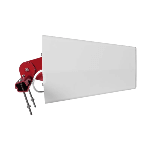
Wide-band directional antenna with up to 9.2 dBi
Buy Now For $139.99The Yagi antenna (also known as a Yagi-Uda antenna) was invented in 1926 by Japanese inventors Shintaro Uda and Hidetsugu Yagi. Since then, they have played a major role in RF transmission around the world. Improving cellular signal is one of the most common uses of a Yagi antenna and this article will specifically cover cellular Yagi antennas.
What is a Yagi Antenna?
A Yagi antenna is a directional antenna that improves radiation in a single direction, and such radiation can be either transmission or reception of energy, such as cell signal.
What is a Yagi Antenna Used For?
Yagi antennas have different purposes. At an industrial level, they can work for radars to detect movement or for ham radio. At a consumer level, they can be used to enhance Over-The-Air television reception and, nowadays, cellular Yagi antennas can boost cell signal at home or at work where remote areas struggle to ensure quality in telecommunications. However, we don't recommend using them to boost cell signal in your vehicle. We will explain why in a moment.
How Does a Yagi Antenna Work?
A Yagi antenna works through the interaction of four essential pieces:
- Driven Element: The driven element of a Yagi is the point where the feed line is attached from the transmitter to the Yagi to perform the transfer of power from the transmitter to the antenna.
- Director(s): Used to provide the antenna with directional power and gain.
- Line: The spine of the antenna used to hold the directors and reflectors and connect to the driven element.
- Reflector: Used to reject signal outside its range as well as amplify what's inside - think of a mirror reflecting light.
These pieces allow Yagi antennas to achieve higher gain than omnidirectional antennas.
They don't perform well in a vehicle, as driving or sailing creates a constant change of direction. However, the directional nature of a Yagi makes it ideal for home and commercial installations, as it allows for greater gain and reach.
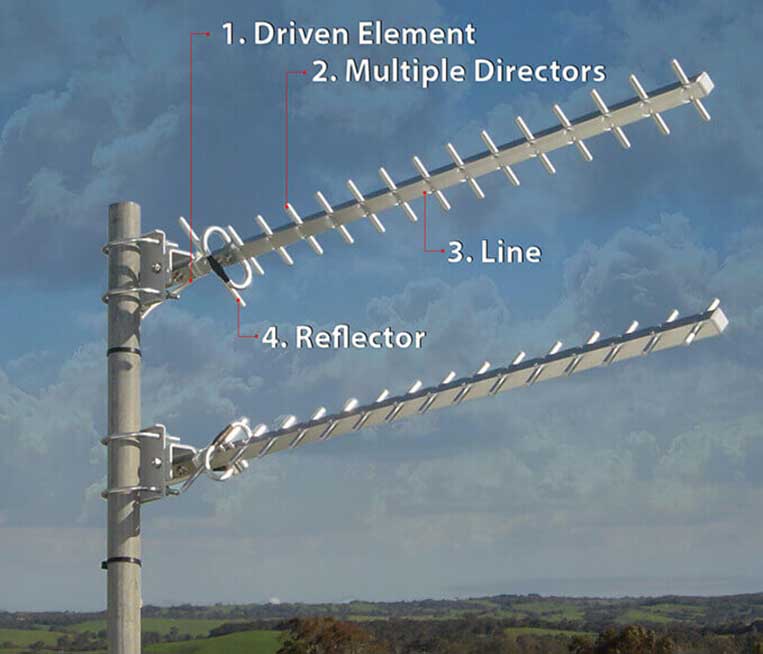
Is a Yagi Antenna Directional?
Yes. To be exact, a Yagi antenna is unidirectional, and that's the main feature when improving cell signal: it aims to maximize the reception of signal from a particular carrier in just one direction.
How Far Can a Yagi Antenna Reach?
A typical Yagi is effective up to 5 miles – but generally speaking will work best up to around 3. If you're seeking to amplify cell signal, Yagi antennas come with either 50 or 75 ohm configurations, depending on the use case of your system (commercial or consumer usage). Yagi antennas are three times more powerful than omnidirectional antennas because they are frequency-specific, work with one or two carriers, and can be placed to reach the best possible signal wherever you are.
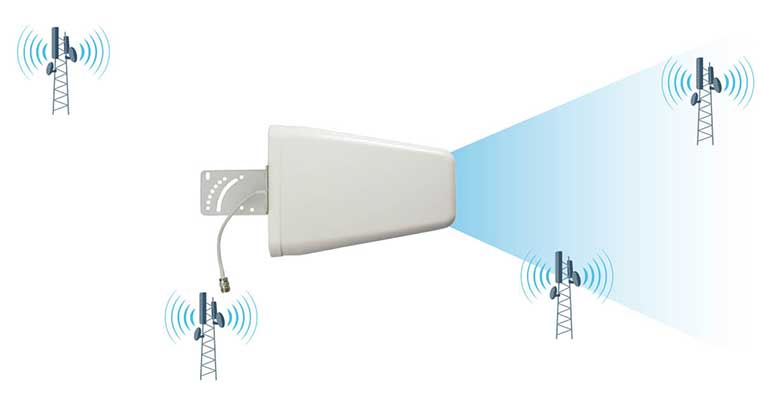
How Do I Aim a Yagi Antenna?
You should aim the outdoor antenna in the direction that best receives the signal from your carrier because a Yagi antenna will not receive any signal that is out of the direction they point to. In other words, if your carrier is out of the beam of the antenna, you won't receive the boost you're looking for. Thus, we recommend finding your nearest cell tower before pointing your yagi antenna.
Omnidirectional Antennas: The Simple Setup
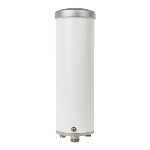
Popular omnidirectional rooftop antenna with up to 5 dBi
Buy Now For $111.99Omnidirectional (or omni) cellular antennas pull in signal from all directions. Cellular omnidirectional antennas are common sights in low-lying areas, or attached to the sides of commercial buildings. While omnidirectional antennas exist for all sorts of RF, this article will focus on cellular.
What is an Omnidirectional Antenna Used For?
Omnidirectional antennas are the most useful for multi-carrier setups and are far easier to install than other outdoor options. They pull in all existing signal in an area. This has several advantages, but also a few disadvantages.
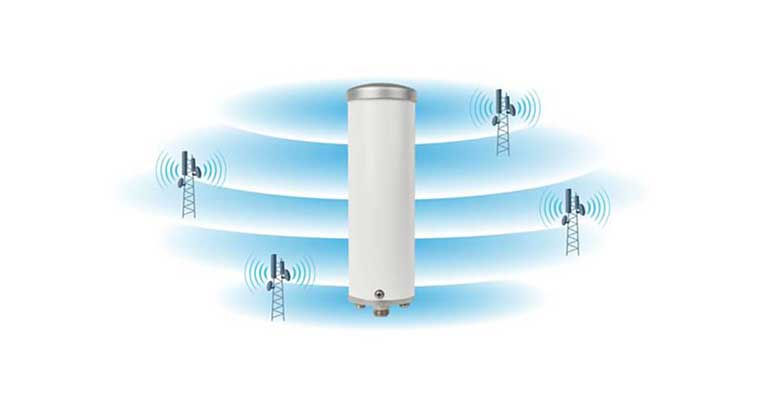
What are the Advantages and Disadvantages of an Omni-Directional Antenna?
There are three major advantages to omnidirectional antennas:
- Easy installation
- Will amplify all cell signal in your area, from multiple carriers with different cell towers in multiple locations
- Superb in strong signal areas and low-lying valleys
However, they also have some disadvantages when compared to Yagi and LPDA antennas:
- Don't reach as far as a directional antenna
- Don't give as much gain to your incoming signal as a directional antenna
- Susceptible to “signal noise" and can become overwhelmed in extremely busy urban areas
- Not optimized for rural areas where distance from the cell tower is the main problem
There are also some physical limitations to omnidirectional antennas that warrant bearing in mind.
All that said, omnidirectional antennas work extremely well in strong-to-middling strength signal areas, and, when paired with a powerful enough amplifier, are more than equipped to do a great job.
Cellular Log-Periodic Dipole Array (LPDA) Antenna: The Highest Power
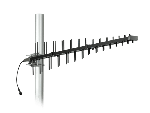
Powerful directional antenna with up to 13.1 dBi
Buy Now For $359.99Log-periodic antennas are known by many names: LPDA (short for log-periodic dipole array), log-periodic dipole antenna, log-periodic aerial, or just a log-periodic array. They have a simple job: to operate over a wide band of radio frequencies. What these frequencies bandwidths are vary based on the type of log periodic antenna you buy.
They're more common than you might think. You've probably noticed log periodic antennas in passing all your life, sitting atop suburban and rural rooftops, poking out on apartment balconies. Traditionally, log periodic antennas have been used for analog television, which was the dominant style until digital eclipsed and replaced it in the recent past. Even still, they remain used in many areas, and, as a quick search for a TV antenna will show you, they continue to dominate that market.
The reason for this is simple: they have excellent range and can cover a wide range of broadband frequencies. Their directivity allows them to have a narrower focus than their cousins the Yagi antenna, which gives them increased power over their brethren. Properly installed, they will work in fringe areas Yagi's just can't.
How Do Log Periodic Dipole Array (LDPA) Antennas Work?
Log periodic antennas (hereafter referred to as ‘LPDA' or ‘LPDAs') normally consist of half-wave dipole elements each consisting of a pair of metal rods positioned along a support boom lying along the antenna axis. The spacing of these elements are what allow for the tuning of the frequency range of the LPDA - meaning, cellular LPDAs are finely tuned in such a way as to pick up cellular frequencies between the 698-2700 MHz frequencies. Other LPDA antennas focus on VHF/UHF, WiFi, and other wavelengths in the high frequency GHz spectrum.
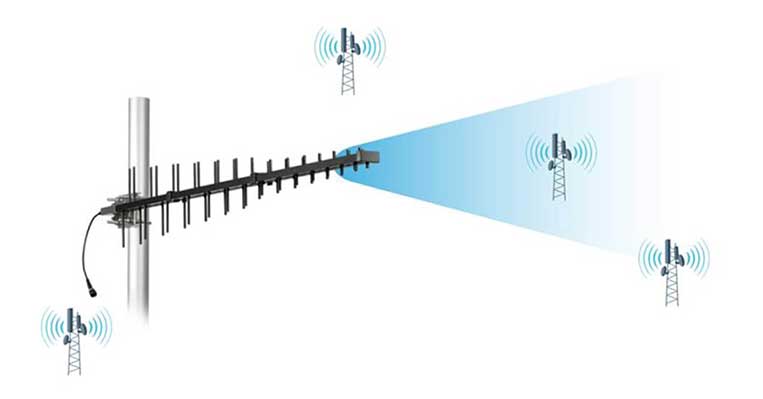
LPDA antennas are contrasted with EMC antennas, which operate electromagnetically, and array antennas, which are big, complicated arrays of numerous antennas that can both transmit and receive. LPDAs are significantly more diverse in their usage - they can operate off standard power and can be installed just about anywhere at not too great of a cost.
LPDA antennas focus on antenna gain (measured in dBi). While a Yagi or omni antenna focuses on bringing in signal within relatively close environs, the LPDA can work adequately in fringe conditions. This is accomplished with a relatively focused radiation pattern, at a roughly 30-degree beamwidth.
A radiation pattern with such high gain and wide bandwidth is achieved by creating a three-element Yagi antenna. These are called driven elements, connected electrically to the feedline. This feedline - usually coaxial cable, but sometimes twin-lead or ladder line - zig zags between the dipole elements. Certain LPDAs are known as log-periodic zig zag antennas because they replace the dipoles with the feedline itself.
Yagi vs. Omni vs. LPDA: Which Cellular Antenna is Best for Me?
There are a few major differences between the three major cellular antennas (Yagi, omni, and LPDAs), all of which have been hinted at above.
How They Are the Same
Omnidirectional antennas, Yagi antennas, and LPDAs pull in existing cellular signal (5G, 5G E, 4G LTE, and 3G, depending on the bandwidths covered by the antenna). All of them increase the power of the signal upon pulling it in, but the extent to which that happens varies depending on the type.
How They Differ
Omni antennas are the standard antenna type. They catch signal in a 360-degree field, and do not discriminate. They will seize any cellular signal that exists, whether you want it or not. This is great if you have several cell sites nearby, since you can easily multiple carriers at once. Omni-directional antennas nearly always look like rod shaped cylinders. Think of a radio antenna you might have on your car - this is an omni antenna.
The main disadvantage of an omni antenna is its power. Due to its 360-degree radiation pattern, both its range and overall dBi gain are lower than directional antennas.
However, this disadvantage comes with some very real perks: omni antennas are ideal for multi-carrier setups in strong outside signal environments. Many of our corporate clients prefer omni antennas, because they usually need to service multiple carriers (Rogers, Telus, Bell, etc.) inside their buildings.
Although it’s plausible for two same-carrier towers to be close enough to each other that the omni-antenna pulls in signal from both, it's most likely a rare situation. Depending on the location, you’ll most likely be close to one of each carrier tower (i.e., one Rogers, one Telus, one Bell, etc., not two Rogers, three Telus, one Bell, etc.).
That's where an LPDA or Yagi antenna come in. These are more specialized, with Yagi antennas being more general use than LPDAs. Their directionality allows for longer range and higher gain, with the LPDA being more directional than the Yagi. This directionality allows for more precise and powerful signal to reach your amplifier.
The more remote you are, the more directional you'll want to think. Conversely, if you're in an extremely urban area and are bombarded with irrelevant signal, becoming more directional can help with that, too.
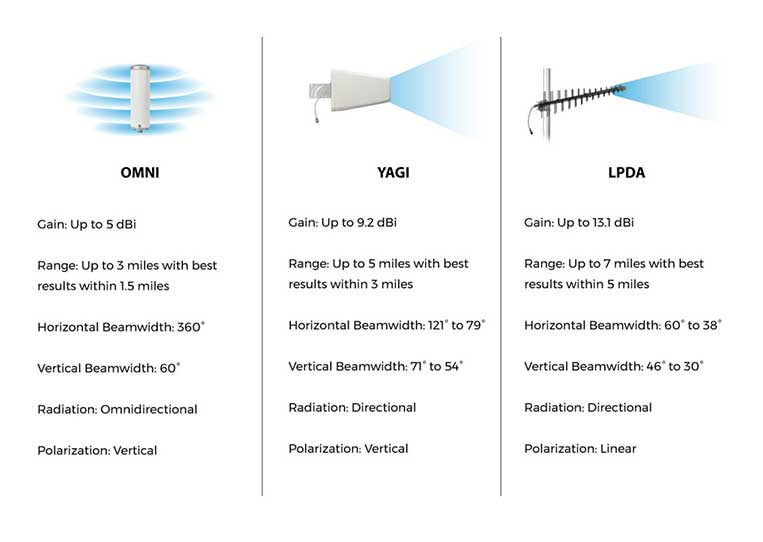
Which Outdoor Antenna Gives the Highest Gain?
Log-periodic dipole array (LPDA) antennas give the highest gain in almost every situation. LPDA antennas have longer range and higher gain than Yagi and omnidirectional antennas but are harder to aim and very directional. However, these are far and away your best option in rural or weak signal areas.
What an Indoor Cellular Antenna Does, and How to Use Them
Indoor cellular antennas are the piece which broadcasts the cellular signal captured by outdoor antennas in buildings. Like outdoor antennas, they come in two varieties: panel and dome.
Panel and dome antennas get their name from their shape, which plays a role in how they operate. The dome shape allows the antenna to broadcast the boosted signal in every direction, making it a type of omni-directional antenna. A panel antenna only broadcasts signals in one direction, making it a directional antenna.
These need to be placed where you most desire signal. The closer you are to the radiation pattern of the indoor antenna, the stronger your signal will be. This directly affects the coverage area of your signal booster system.
Panel Antennas: Versatility and Power
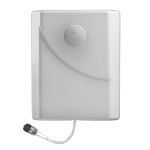
Popular in-building directional antenna with up to 10.6 dBi
Buy Now For $86.99The majority of weBoost signal booster kits by Wilson Electronics use panel antennas. They are wall-mounted and send signals in a directional cone ranging from 45 to 70 degrees. Having such a narrow focus allows for stronger signal at the source (i.e. the closer to the panel antenna, the better the signal).
On average, they give 75 feet of coverage. This varies depending on how strong the outside signal is. If there is strong signal outside, there will be more coverage. Weak signal areas will get less.
The reason why panel antennas are generally recommended first is because of inside interference, and their higher gain. Building materials such as metal, concrete, and energy-efficient barriers can disrupt signals from penetrating the building. Once inside with the help of a signal booster, dense walls and other RF-disrupting material (metal, glass, sheetrock, etc.) can equally disturb the signal coming from the inside antenna.
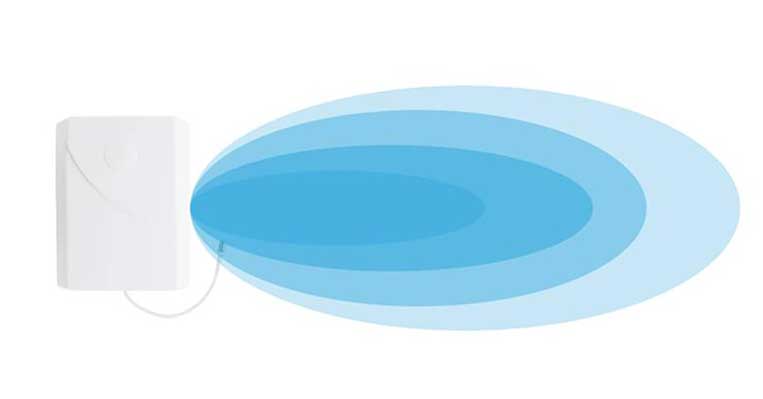
With a panel antenna, you're able to focus the signal within a specific location in your home or commercial building that needs better signal, such as your living room, home office, or conference room. As a result, the signal being broadcasted in that area will face minimal interference. Every device in that room will receive better signal and faster data first before the signal spreads to lower priority areas.
To improve the signal in the rooms with limited to nonexistent coverage, the panel antenna can be installed right side up or upside down on a wall, and in some cases on a high ceiling. If installed on the ceiling, due to its beamwidth and strength, it can also improve the signal in the lower levels of your house or commercial building. However, the signal won't be as strong in the lower levels as it is in the room where the antenna is located because the building materials it must travel through interferes with the signal's strength.
Dome Antennas: Convenience and Coverage
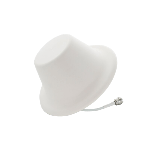
Popular ceiling mount omnidirectional with up to 5.1 dBi
Buy Now For $97.99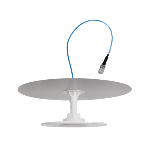
Powerful & discreet in-building omni with up to 7 dBi
Buy Now For $189.99Dome antennas are ceiling-mounted and broadcast amplified signal 360 degrees horizontally - think of its broadcasting beam as half a sphere. This provides a wide horizontal spread of coverage to deliver equal signal in every direction.
Depending on your outside signal strength, on average you'll get about 50 feet of coverage with a dome antenna. Areas with poor cellular service will probably receive much less coverage.
When considering a dome antenna, keep in mind that you'll need access to a crawl space or attic for proper installation. Thus, they tend to be better for commercial use, one-story homes, or multi-level homes with drop ceilings.
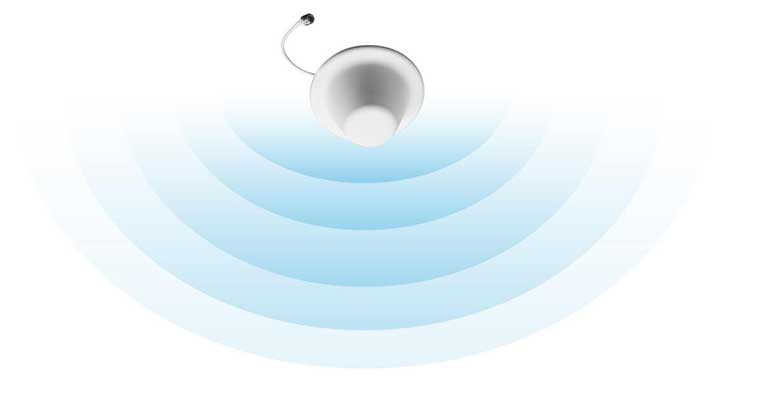
When installed under perfect conditions, meaning low ceilings and zero to minimal inside interference, dome antennas are phenomenal at broadcasting improved 3G, 4G LTE, and 5G signals in large areas.
However, if you have high ceilings (usually 20-30 feet or higher) and thick or numerous walls, then a dome antenna isn't be recommended, since the signal will weaken the further it travels.
Dome and Panel Antenna Gain
Every type of antenna has a certain amount of gain associated with them, measured in dB (decibels). Simply put, gain represents an antenna's ability to direct the signal it's broadcasting and how far the signal can travel. Antennas with high gain usually mean they are more directional, which results in more reach. On the other hand, lower gain antennas tend to be the opposite. We've covered this in the outdoor antenna section.
Panel antennas, since they are directional, will have more gain and reach than a dome antenna. Our regular dome antennas feature up to +5.1 dB of gain and the low-profile dome antennas feature up to +6 or +7 dB of gain, while the panel antennas tend to feature up to +7.6 dB or up to +10.6 dB of gain.
If you live in an area with weak signal, a higher gain antenna will probably be your best option. This will allow the broadcasted signal to be a tad bit stronger and travel a tad bit further in your home or commercial building than it would with a dome antenna.
Panel vs. Dome: Which Should I Get?
A good rule of thumb when trying to choose between dome and panel antennas is to think about:
- The shape of the area in which you want to boost the signal
- What inside interference exists in the area
- How much of a priority is coverage in that area
Do you have lots of inside interference - thick walls, metal, and glass - around your home or building? Is there a specific area you want priority service, such as a closed off room or corridor? If you answered yes to any of those questions, then go with a panel antenna.
Do you have open spaces with virtually no walls, thin walls, or minimal inside interference? Do you want to broadcast an equal amount of signal throughout your home or building? Do you have low ceilings and access to a crawl space or attic? If yes, then go with a dome antenna.
Depending on your outside signal strength and the size of your building, it's entirely possible one antenna will not be enough to provide the coverage you want, especially in multi-level residential or commercial buildings. To maximize your coverage area, you may want to consider getting splitters and a combination of panel and dome antennas. If you decide to purchase additional antennas, make sure their impedance rating of 50 Ohms or 75 Ohms matches that of your signal booster, otherwise, you'll need additional connectors and adapters and have more loss.
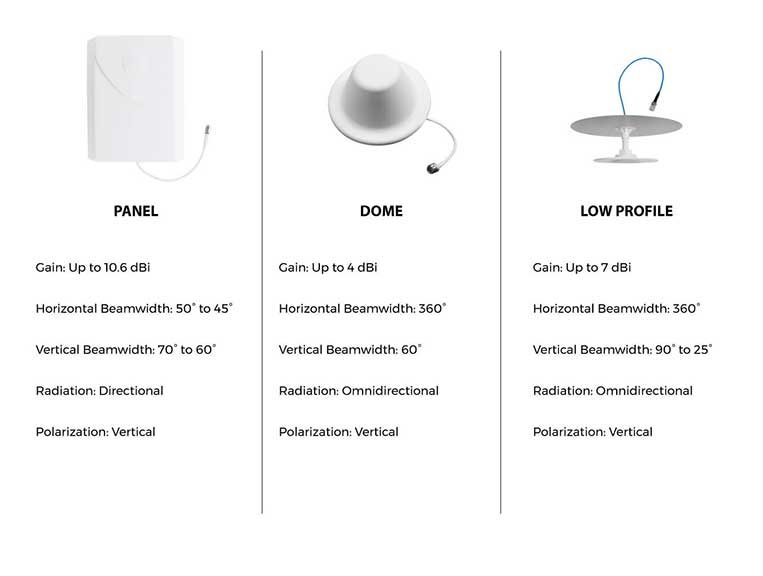
Other Indoor Antenna Types
Dome and panel antennas are not the only types of indoor antennas available; they are just the most common. There are two other types of indoor antennas that can be paired with booster systems designed to cover one to two rooms, such as the weBoost Home Studio and the weBoost Home Room.
- Terminal Antennas or Whip Antennas attach directly to the signal amplifier - similar to a WiFi router's rubber ducky antenna. They're omni-directional just like the dome antenna but not as powerful.
- Desktop Antennas have a nice, discreet design. They are omni-directional and can be placed on any flat surface for better signal wherever you need it most. They can even be used in vehicles!
How to Avoid Signal Oscillation Between Cellular Antennas
Oscillation is one of the most common answers to the question: “Why doesn't my cell signal booster work?"
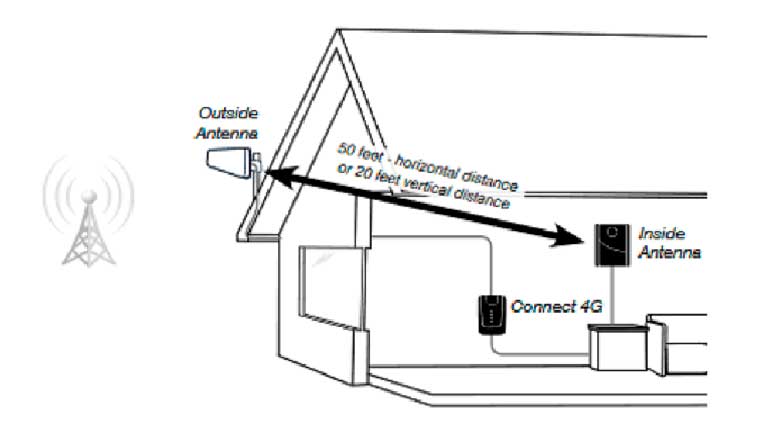
It's a feedback loop between your two antennas, caused by them being installed too close together.
Think of a speaker and a microphone. When you bring the microphone too close to a speaker, an unpleasant humming sound is created, with the screech getting louder and louder the closer they are together. This is oscillation, and it occurs with your antennas, too.
This is a problem that's fixed by increasing the distance between the three components of your signal booster. Your antennas need to be at least 50 feet apart horizontally, or 20 feet vertically in order to prevent oscillation. Unfortunately, if you've set up your antennas for your ideal setup, you may have to move one or both antennas to a slightly less optimal position for you to get rid of the oscillation. However, this is balanced by the fact that the booster's performance will dramatically increase, and that should more than make up for the fact that the broadcast antenna might not always be in the perfect position.
How to Prevent Signal Booster Overload
Most consumer boosters have the possibility of overload. If you've bought a cheaper signal booster, have fantastic outdoor signal but terrible indoor signal, and use high-gain antennas and cable, you might be delivering too much signal to your booster, and overloading it. This causes the booster to shut down completely, in order to save itself.
Fortunately, this is very easy to fix, with multiple options as to how you go about it.
If you want to throw money at the problem and deal with it easily, we sell attenuators to slightly decrease the amount of signal you're bringing in and prevent overload. There are also commercial-grade boosters that automatically attenuate the signal you're receiving, but they come with a rather high price tag and are overkill for most home setups.
If you don't want to spend any more money, you'll need to place your antenna differently. There are two options for this: placing it in a spot with weaker signal than where you have it or turning it away from a signal that's too strong, thereby attenuating the signal. This is the easiest, cheapest method, if you don't mind going on the roof again.
What is a Vehicle Cellular Antenna, and How Do I Use Them?
Vehicle antennas can be thought of as smaller, portable versions of indoor and outdoor antennas. The biggest difference is that every outdoor vehicle antenna is omnidirectional, since vehicles are prone to moving about and will need to constantly broadcast and downlink cellular signal. Thus, the difference between vehicle outdoor antennas is simply how large and powerful the antennas are.
Magnet Mount Antennas: Easy to Use, Easy to Install
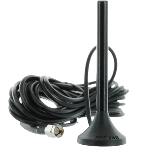
Compact magnetic roof antenna for any vehicle with up to 2 dBi
Buy Now For $20.99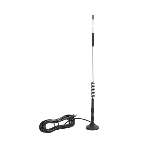
Magnetic roof antenna for any vehicle with up to 5.5 dBi
Buy Now For $32.99Magnet mount antennas should need no introduction – they're simply little antennas you mount magnetically to the frame of a vehicle. They provide minimal gain but have far and away the simplest installation, unless you have an aluminum frame. A magnet mount antenna can be used on any vehicle viably, but struggle at times to cover larger interiors.
The most common magnet mount antenna is the 4" magnet mount, which comes standard in vehicle signal booster kits. There are also 12" magnet mounts, which provide a bit more gain across the standard cellular bandwidths. These are inexpensive upgrades and should be considered by anyone who is having issues covering the cabin of their vehicle with a powerful vehicle booster like the weBoost Drive Reach.
Over-the-Road (OTR) Antennas: For Trucks and Large Cabins
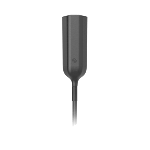
Rugged hard-mount antenna for trucks, RVs, and SUVs with up to 4.3 dBi
Buy Now For $139.99An Over-the-Road Antenna is a mounted antenna designed for semi-trucks and RVs, but can be used in pickup trucks or large SUVs. These are much larger and more powerful than a magnet mount, but are more challenging to install. If you spend lots of time on the road, or have a large cabin or interior, an OTR antenna can be a very valuable investment.
There isn't too much to go into here: an OTR is a more powerful omnidirectional vehicle antenna. If your vehicle is large enough to warrant it, you spend considerable time in your vehicle outside of urban areas, or you're not getting the boost you need from a magnet mount and a powerful mobile booster, then an OTR will help you.
NMO Antennas: Permanent Installations for Commercial Fleet Vehicles
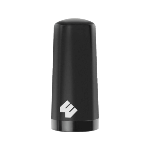
Best external antenna for fleet vehicles with up to 3.2 dBi
Buy Now For $69.99“NMO" (New Motorola Mount – yes, really) antennas are a bit of an odd duck in the vehicle space. For cellular purposes, they're permanently installed in a fleet vehicle – whether that be a taxicab, delivery van, or semi-truck - in order to get increased gain over a magnet mount. These are very valuable for businesses which rely heavily on their fleets.
If you have a series of fleet vehicles, give us a call at 1-800-919-7442 and we'll get you sorted out.
Magnet Mount vs. OTR vs. NMO: Which Cellular Antenna is Best for My Vehicle?
This is a simpler choice than with building antennas.
- Cars: 4" / 10.2 cm magnet mounts are sufficient for most cars. Upgrade: 12" magnet mount
- SUVs: 4" / 10.2 cm magnet mounts work on most SUVs. Upgrade: 12" magnet mount or OTR
- Pickup: 4" / 10.2 cm magnet mounts work on most pickups. Upgrade: 12" magnet mount or OTR
- RVs: OTR. 4" / 10.2 cm magnet mount will work in a pinch.
- Semi-trucks: OTR. 12" / 30.5 cm magnet mount will work in a pinch.
- Fleet vehicles of any type: NMO. OTRs will work as an alternative
Other Types of Vehicle Cellular Antennas
There are a few other types of vehicle antennas to go over, but their use cases are less complex:
- Marine antennas are large, waterproof antennas designed to be used aboard...well, marine vehicles. They can be used to ensure cellular coverage of a boat's cabin up to several miles offshore. Get one of these if you have a boat.
- Low-profile antennas are the most common type of interior antenna for vehicles, being packaged in nearly every multi-user kit. They resemble candy bars and are designed not to stand out and transmit directionally.
- Desktop Antennas are small interior antennas best used in RVs or vehicles with extremely large cabins. They are trickier to place than low-profile antennas but provide slightly higher gain.
Frequently Asked Questions
Is Higher dBi Better for Antennas?
In general, yes. However, there are many reasons you might consider dropping a few dBi levels: convenience of installation, getting multiple carriers in your network, overall cost, and whether your booster is likely to overload from too much incoming signal.
How May We Help
Wilson Amplifiers is the leading provider of Industry Canada approved weBoost and WilsonPro home, office, and vehicle signal boosters. Cell phone boosters amplify 4G and LTE for any phone across any carrier. They are 5G ready and will be able to be used until 2030 and beyond. For optimal performance, we can help get you set up with the best indoor and outdoor antennas.
We seriously hate dropped calls and poor coverage, so it's our goal in life to stomp out spotty signal:
- Free consultations. Email us at sales@wilsonamplifiers.ca or call us at 1-800-373-29237.
- Better signal or industry-leading 30 day money-back guaranteed. No questions asked.
- Lifetime technical support.
Ask us anything and we'll be glad to help.


Money Back Guarantee

Technical Support